#queen elizabeth of hungary
Explore tagged Tumblr posts
Text

Queen Elizabeth of Hungary and the Court Painter
Artist: James Dromgole Linton (English, 1840–1916)
Date: c. 1910
Medium: Oil on canvas
Collection: Sheffield Museums, United Kingdom
Elizabeth of Hungary
Elizabeth of Hungary (7 July 1207 – 17 November 1231), also known as Elisabeth of Thuringia, was a princess of the Kingdom of Hungary and the landgravine of Thuringia.
Elizabeth was married at the age of 14, and widowed at 20. After her husband's death, she regained her dowry, using the money to build a hospital where she herself served the sick. She became a symbol of Christian charity after her death in 1231 at the age of 24 and was canonized on 25 May 1235. She is venerated as a saint by the Catholic Church. She was an early member of the Third Order of St. Francis, and is today honored as its patroness.
#queen elizabeth of hungary#painting#court painter#indoor scene#drawing#oil on canvas#costume#hungarian history#crown#queen#woman#seated#full length#english art#english painter#fine art#james dromgole linton#european art#20th century painting#artwork#oil painting
39 notes
·
View notes
Text


Hetalia Sticker sheets for a con/artist alley this weekend! Can you spot all the historical references?
#historical hetalia#hetalia fanart#hetalia art#aph italy#aph germany#aph japan#aph america#aph england#aph france#aph russia#aph china#aph austria#aph hungary#aph prussia#my art#hetalia axis powers#hetalia world stars#Me every time i make a hetalia: if i dont reference Habsburgs i will DIE#Anyway. Italy's backdrop Medici family crest. Germany's backdrop & font Bauhaus. Japan imperial chrysanthemum.#Prussia Old Fritz's Pour le Mérite. Austria Habsburg flag+crest & Habsburg facial features incl jaw. Hungary traditional tulip#France Louis XIV Versailles sun emblem & facial features. Russia Romanov eagle & soviet backdrop & st basil domes#China imperial dragon and communist star. England queen Elizabeth ii stamps
32 notes
·
View notes
Text

Sándor Liezen-Mayer - Queens Elizabeth and Mary at the Tomb of King Louis the Great of Hungary in 1385.
Versions >> 1 | 2
#Sándor Liezen-Mayer#Queens Elizabeth and Mary at the Tomb of King Louis the Great of Hungary#on your knees#crying#mourning
11 notes
·
View notes
Text

Saint Elizabeth of Portugal
1271 - 1336 Feast day: July 4 (New), July 8 (Trad) Patronage: victims of adultery, jealousy, and unfaithfulness; Portugal; brides; charitable societies and workers; difficult marriages; falsely accused people; widows
St. Elizabeth of Portugal, also known as St Elizabeth of Aragon and St Isabella of Portugal was queen consort of Portugal and a tertiary of the Franciscan Order. Her great aunt was St. Elizabeth of Hungary, after whom she was named.
Prints, plaques & holy cards available for purchase here: (website)
80 notes
·
View notes
Text










Women’s History Meme || Empresses (2/5) ↬ Catherine de Valois-Courtenay (before 15 April 1303 – October 1346)
The official Neapolitan investigation into Andrew of Hungary’s murder targeted Johanna’s closest supporters and left her isolated and vulnerable. Her aunt, Catherine of Valois, took advantage of that vulnerability to become the queen’s confidant in order to make certain that one of her sons would be Naples’s next king. At first, it appeared that this son would be Robert, the eldest of the Tarantini, who for a time seemed to be winning the competition between the Angevin princes for power and whom Johanna requested a papal dispensation to marry. Soon, however, Louis gained the upper hand, and Johanna’s requests for dispensations began to identify him as her intended. — From She-Wolf to Martyr: The Reign and Disputed Reputation of Johanna I of Naples by Elizabeth Casteen Of the many relatives who chose to avail themselves of the glittering social whirl of the capital, one stood out: Joanna’s aunt, Catherine of Valois, widow of Robert the Wise’s younger brother Philip, prince of Taranto. Catherine was Joanna’s mother’s older half-sister (both were fathered by Charles of Valois). Catherine had married Philip in 1313, when Philip was thirty-five and she just ten. Catherine was Philip’s second wife. He had divorced his first on a trumped-up charge of adultery after fifteen years of marriage and six children in order to wed Catherine, who had something he wanted. She was the sole heir to the title of empress of Constantinople. … Catherine was twenty-eight years old, recently widowed, and a force to be reckoned with when the newly orphaned Joanna and her sister, Maria, first knew her at the Castel Nuovo in 1331. Shrewd, highly intelligent, and vital, Catherine was supremely conscious of her exalted ancestry and wore her title of empress of Constantinople as though it were a rare gem of mythic origin. Even the death of her husband, Philip, in 1331 had not dissuaded her from persisting in her efforts to reclaim the Latin Empire for herself and her three young sons: Robert, Louis, and Philip. A series of shockingly inept leaders had left the Byzantine Empire vulnerable to attack from the west, and this state of affairs was well known in Italy. Moreover, Catherine was used to getting her way. — The Lady Queen: The Notorious Reign of Joanna I, Queen of Naples, Jerusalem, and Sicily by Nancy Goldstone
#women's history meme#historyedit#catherine of valois#house of valois#capetian house of anjou#medieval#french history#italian history#european history#women's history#history#nanshe's graphics
42 notes
·
View notes
Text
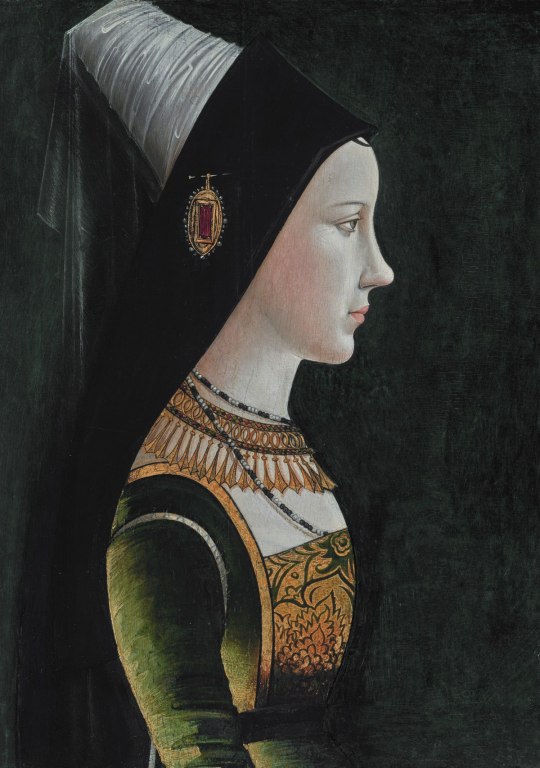


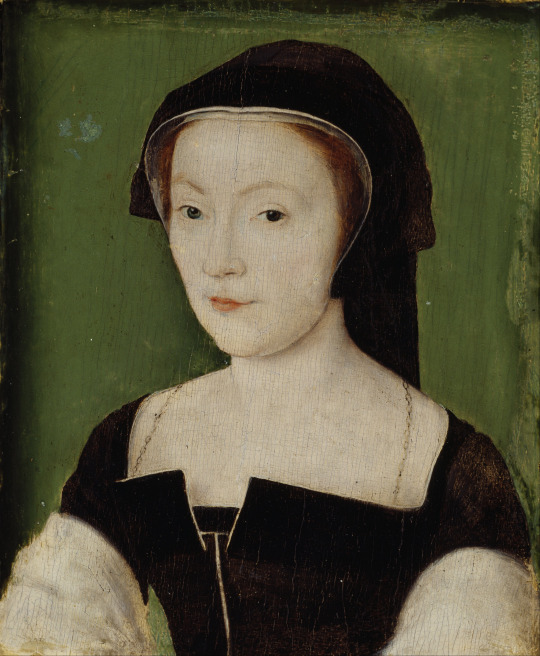
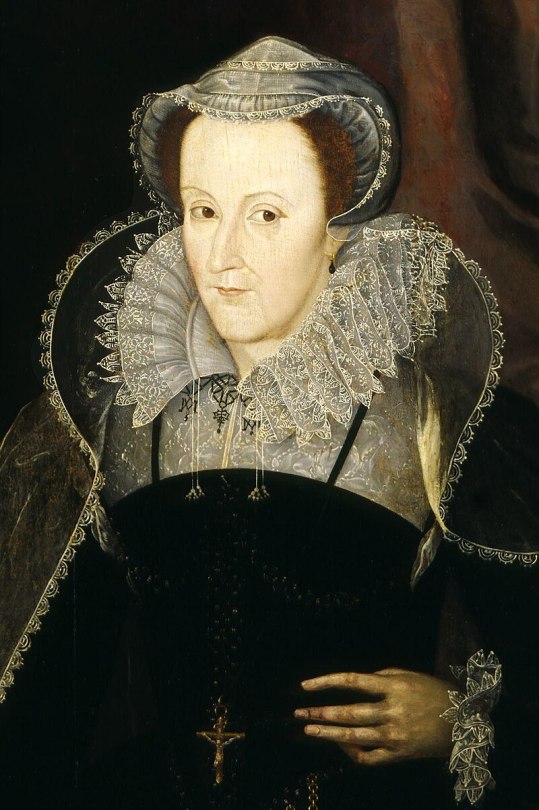
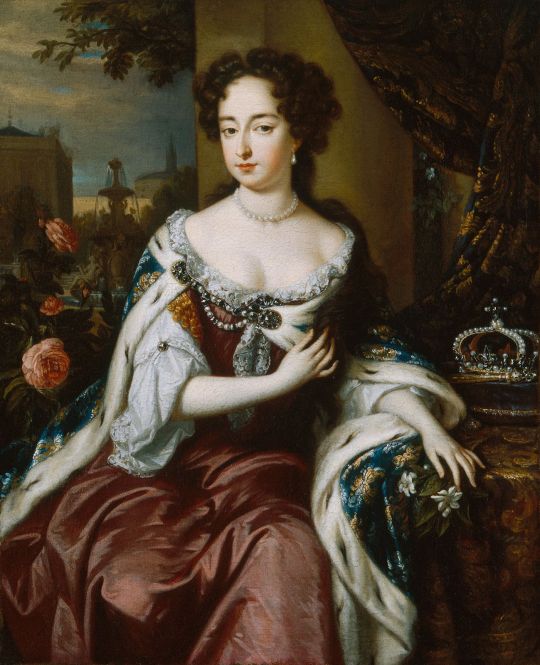
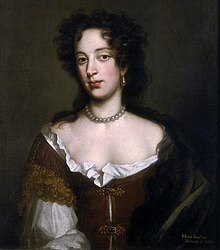

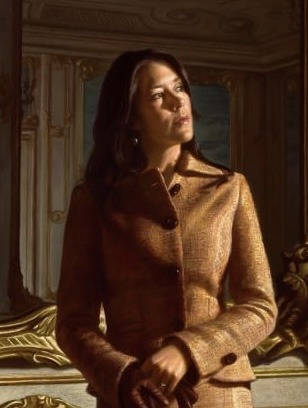
9 Royal Mary’s of history - Reigning and Consorting: -> 1. Mary of Burgundy: Consort of Maximilian I, Holy Roman Emperor (1457–1482). -> 2. Mary of Hungary (Mary of Habsburg): Queen consort of Louis II of Hungary and Bohemia (1505–1558). -> 3. Mary I of England: Reigned 1553–1558 (1516–1558). -> 4. Mary of Guise: Queen consort of James V of Scotland, regent for Mary, Queen of Scots (1515–1560). -> 5. Mary, Queen of Scots: Reigned 1542–1567 (1542–1587). -> 6. Mary II of England: Reigned 1689–1694 (1662–1694). -> 7. Mary of Modena: Queen consort of James II of England, regent for James Francis Edward Stuart (1658–1718). -> 8. Mary of Teck (Queen Mary): Consort of George V of UK, reigned 1910–1936 (1867–1953). -> 9. Mary Elizabeth Donaldson (Queen Mary): current Queen consort of Frederick X of Denmark since 14th January 2024 (1972-).
#ktd#Royal history#european history#Mary I#mary ii#mary queen of scots#queen mary#Mary of teck#Mary of Modena#Mary of guise#Mary of burgundy#Mary of Hungary#European royalty#royal#royalty#brf#british royal family#british royalty#british royal fandom#Art#art history#Denmark
74 notes
·
View notes
Note
How... hm, how to put this... how aware were rulers of regarding other nations in the medieval and early modern periods? Like, would the ruler of Portugal know who the Timurids were? Or what was going on in Muscovy at the time? Like, how far east and south did their knowledge go before it turned into "Here Be Dragons" legend and rumor? Did they know who the Mali and Songhai were?
The answer is that it depends, largely due to differing geographies and trade patterns and time periods. For example, the ruler of Portugal might well know who the Timurids were - if it was after Vasco de Gama's "discovery" of the Cape Route to the Indian Ocean, because it's just a quick jaunt up the Indian coast to get to the Persian Gulf.

I doubt the King of Portugal would have much to do with the Tsar of Russia, but Queen Mary and Queen Elizabeth I of England definitely did - because the English government had chartered the Muscovy Company in 1555, which ferried diplomatic exchanges between Ivan IV and Elizabeth I along with the huge cargo of wool for fur and fur for wool.

And certainly the monarchs of western and central Europe would have been familiar with the kingdoms of eastern Europe, because they were all fucking inbred relations of each other.
For example, Louis the Great was King of Hungary, Croatia, and Poland, but he was also of the House of Anjou and his brother was the Duke of Calabria who married to the Queen of Naples, who also was the Countess of Provence and the Princess of Achaea. - and after his brother was assassinated, Louis invaded Naples and claimed the title of King of Naples, Sicily, and Jerusalem!

Similarly, Henry III of France was elected King of Poland and Grand Duke of Lithuania in order to keep out the Hapsburgs, and Henry's mother was Catherine de Medici. So there was probably a lot of knowledge of different countries just from family letters...

As for Mali and Songhai, the Portuguese and the Dutch "traded" extensively with West Africa in the 15th-17th centuries. So they certainly would have traded with the Mali and then the Songhai Empires. But I doubt the Tsar of Russia would have known much about them, and so it goes...

114 notes
·
View notes
Text
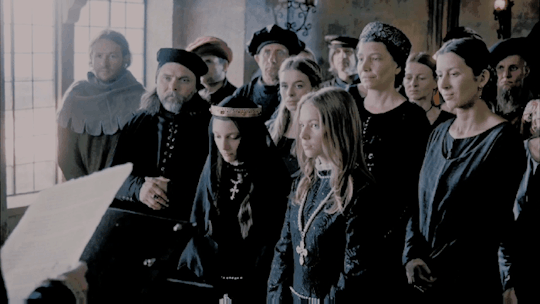
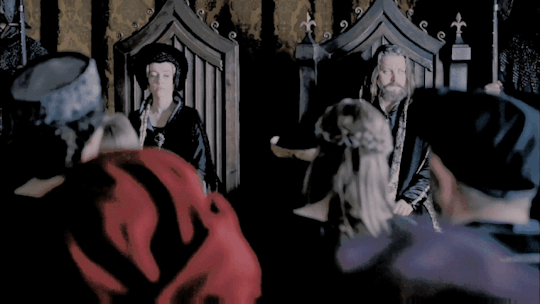
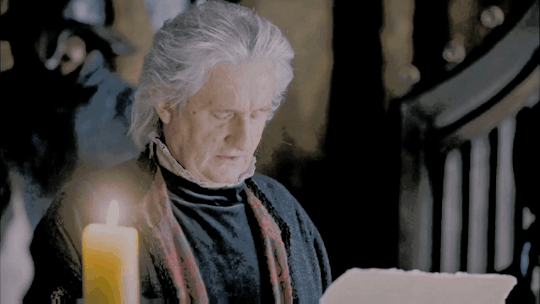
“It seems like she [ Elizabeth of Poland ] already prepared one will, during her first years of stay in Poland, but only the above-mentioned [ made in April 6th 1380 ] survived, which is by all means interesting. At the beginning, Elizabeth states that she wants to be buried in the Poor Clares monastery in Óbuda, which she founded and not in the royal graves in Szekesfehervar [ ... ]. She recommends the care of peace of her soul to her son and daughter-in-law, to whom she also entrusts the protection of her favourite monastery. Then there are bequeaths for the royal family, monasteries and courtiers and from them we can learn not only about the wealth of Elizabeth's treasury, but also about many beautiful features of her character.
Her son, Louis, receives several golden vessels, among them a cup, a gift from Naples on which next to the figure of Saint Ladislaus and the Hungarian count of arms, there was also engraved Polish eagle and then relics, except for a painting supposedly painted by Saint Louis, which was received by Poor Clares. To her daughter-in-law Elizabeth she leaves her castle in Óbuda and then her valuables and one of her breviaries, on which she used to pray. The granddaughter, Mary, receives golden tiara decorated with two eagles and a necklace, the second, Jadwiga receives a tiara with lilies and necklace with costly stones. Elizabeth also does not forget about Jadwiga, an orphan from her brother Casimir, who was still hiding in Buda castle, and leaves her the same tiara as the previous two.
Then Elizabeth disposes of her money, from which, after paying off her debtors, she allocates 500 gold florins for exequies after her death and 2,000 for funeral costs of her granddaughter after her son Stephen, the recently deceased Elizabeth, whose body she orders to be brought to Buda. Elizabeth also provides generously to her courtiers: Jan, the provost of Buda receives 400, knight Jakisz 300, page Ladislaus 200 gold florins, Klara de Pukar receives a village, a cart and 6 horses, 400 silver fines and the Queen's second breviary, which, however, Poor Clares are to receive after her death.
What is left after providing the Queen's confessor and a few other courtiers, jewels, dishes, robs, decorations, utensils and 1,000 golden florins is to be distributed equally among all the Queen's courtiers, both Polish and Hungarian. Pages and other courtiers who do not receive separate salery receives 1,000 florins and all the Queen's carriage horses, except six, which will accompany her funeral.
Finally, there are bequests for churches, in which she supplies all the Dominican, Franciscan and Augustinian monasteries throughout Hungary and a number of other temples. Having entrusted her ladies-in waiting to her daughter-in-law and her courtiers to her son, she asks him to not hold menagers of her estates and treasures responsible on the basis of false accusations, because they are trustworthy people, at the same time she hereby cancels all her previous testamentary decrees. She also appoints the executors of her will, including Cardinal Demtrius of Esztergom and her daughter-in-law, Elizabeth. To be sure, two copies of the will were prepared, one of them remained at court and the other was given to the Poor Clares in Óbuda for safekeeping...” — Jan Dąbrowski “Elżbieta Łokietkówna”
24 notes
·
View notes
Text
Incest and the Medieval Imagination, by Elizabeth Archibald: Chapter 4: Fathers and Daughters: The Flight From the Incestuous Father
Chapter 1 | Chapter 2 | Chapter 3 Part 1 | Chapter 3 Part 2 | Chapter 3 Part 3 | Chapter 4 Part 2 | Chapter 4 Part 3 | Chapter 5 Part 1 | Chapter 5 Part 2 | Conclusion
Medieval tales of father-daughter incest aren't nearly as common as tales of mother-son, or even sibling incest. And when they do appear, they often depict a one-sided, predatory relationship, rare are narratives that explore reciprocal affection. The father, typically cast as the villain, is driven by a forbidden desire for his daughter, who is portrayed as a victim. Typically, penance is can only be achieved in cases of unconsummated incest, with fathers who actually lay with their daughters too irredeemable and punished with death.
The narratives of unconsummated incest often focuses on the daughter's adventures after fleeing the father's advances, with the incestuous being just the catalyst for her flight. The father may reappear at the end of the narrative to repent and seek reconciliation. Unwitting incest is a rare motif, and usually appears in it's unconsummated form, with the father and daughter successfully recognizing each other just in time to avoid a marriage.
Unconsummated Incest - The Flight From the Incestuous Father
The "flight from the incestuous father" style of narrative seem to have originated with the 13th Century, taking elements from other popular folktales. There seems to be a huge amount of these narratives, some in long form and some in short form, spread all over Europe. The Vita Sanctae Dympnae, written about 1240, is perhaps one of the earliest exemples of this type, but lacks several parts of the plot that would later become staples. Dymphna was born in Ireland, 7th Century, to King Damon and his Catholic wife, and at a young age made vows of chastity and swore herself to Christ. When the Queen died, Damon started to look for a second wife, but no one other than Dymphna was beautiful enough. Dymphna found out that Damon intended to marry her and ran from the court. Damon did eventually find and kill her, with her remains becoming holy and possessing healing powers, after which she becomes a saint.
Vitae Duorum Offarum, by Matthew Paris (circa 1250), introduced other motif that became central parts of these narratives from that point on, such as the Calumniated wife. Still, didn't yet include all the elements that would be crucial in future versions. For instance, the main character is not the daughter, but her husband, Offa; the story also never accounts for the fate of the incestuous father; and the daughter herself escapes mutilation. It begins when King Offa meets a princess who ran away from home because her father kept making advances towards her. Offa helps her and they marry. Offa departs to battler and the princess' father impersonates him in a letter saying that the princess if a witch and that she and her children must be exposed. Offa's servants do as ordered, but the princess and children are helped by a hermit. When the real Offa return, he becomes distressed by what happened, but rejoices when he rejoices when the hermit tells him that his family is still alive.
Future romance narratives would often include more psychological aspects, such as the king's growing desire towards his daughter daughter (often including his resistance to give into the feeling) and also the daughter's horror at his advances and subsequent prayers for salvation.
The French poem La Manekine (c. 1270) by Philippe de Beaumanoir is not only one of the earliest Vernacular exemples of this plot, but also one of the oldest accounts to include all the relevant motifs. The main character is Joie, the daughter of King and Queen of Hungary. When the queen dies, she makes her husband promise not to remarry unless he finds a woman like her, but since they don't have a male heir, the king is pressured by the court into marrying again. The more Joie grows, the more she looks like her mother, and so, as to not break his promise to his wife, the king demands Joie's hand in marriage. She rejects him and cuts off her left hand is despair, telling her father that now she's a cripple and therefore is not a fitting bride for him. The father orders for the burned as punishment, but the servant takes pity of her and secretly helps her into a boat to Scotland, where the meets the king and marries him. When Joie is pregnant, the king goes for a tournament, leaving Joie with his mother. The mother is very jealous of Joie and forges a letter from the king ordering that Joie and the baby be burned. Once again, Joie is spared by a kind servant, who burns replicas of them and helps Joie and her son to go to Rome. When the King of Scotland returns and discovered what his mother has done he imprisons her and goes after Joie. After seven years, from the King of Scotland and the King Hungary arrive in Rome. The King of Scotland finds Joie and they are joyfully reunited, then the King of Hungary comes across her and tells her than he's seeking penance for his incestuous desire. Joie forgives him and then her severed hand is miraculously found and reattached by the Pope.
While Offarum adds the Calumniated Queen motif to the basic narrative of Dympnae, then Manekine adds the Evil Mother In Law. The mother-in-law's jealousy towards Joie possibly originates from a incestuous obsession with her son, in a way that mirrors Joie's father's obsession with her in the beginning of the story. Both times Joie is exiled is due to parents overstepping the boundary of a healthy parent-child relationship.
The Manekine also has very strong religious message, emphasising Joie's piety and devotion to the Virgin, who in turns heals her in the end. Even the pagan incestuous father finds salvation in God at the end of the story.
While the male heroes from mother-son incest stories hold control over their fate, the female protagonists of father-daughter incest often find themselves adrift and helpless, needing protection of other men (first the husband ,then the servants who spare their lives and finally the stranger who takes them in during their second exile).
This aspect of female helplessness under a patriarchal society is further explored, perhaps not intentionally, by Chaucer in Canterbury Tales in the Man of Law's Tale, which is perhaps inspired by John Gower's Tale of Constance from Confessio Amantis. In Chaucer's narration, Constance's defenceless is often highlighted and the character herself acknowledges that as a woman, she is under men's control.
#parent x child#daughter x father#filicest#parentcest#elizabeth archibald#shipcest#proship#scholarly review#Incest and the Medieval Imagination#book review
7 notes
·
View notes
Text
Stained glass windows with Habsburg females
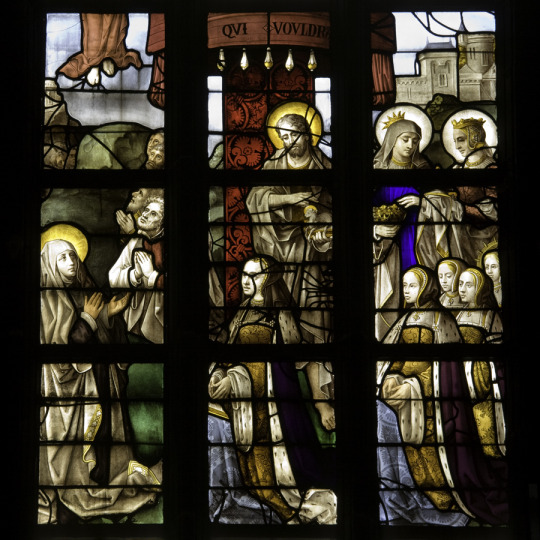
Photo by Michel Lefrancq, wikipedia bears fallowing description:
A part of the stained glass windows of the Assumption in collegiate church Sainte Waudru (Mons, Belgium) by Eve Claix, Ca 1510 depicting Holy Queens Elizabeth of Hungary, Catherine of Alexandria and Queen Juanna of Castille.
I mostly agree but I will clerify few points. The window depicts Queen Joanna of Castile with all four daughters depicted behind her:
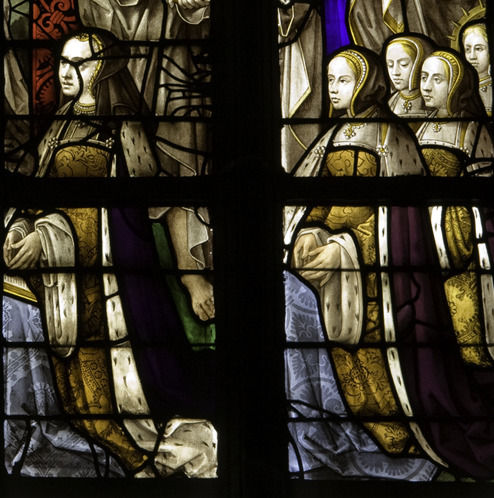
surounded by several saints. The woman before them is probably Virgin Mary.

Above Joanna is is probably her namesake saint John the Baptist(holding lamb), above girls is St. Queen Elizabeth of Hungary(holding two crowns), then St. Catherine of Alexandria holding bridal veil and bit of her wheel is behind head of one of the girls:

Thus only one missing her namesake saint is Eleanor. But i tried to find if saint Eleanor existed and the google proved unconclusive.
According to one webpage it is another name for St. Helena, the rest seem to think the name has french origin, with nothing to do with St. Helana or any other saint.
However, the name might not derive from female saint at all but from male saint(like Joanna's is). In Eleanor's case probably St. Leonard of Noblac. He is usually depicted as an abbot holding some type of chains, often also with a book. Thus he is not here.
This is how it would look if we made the gaps smaller:
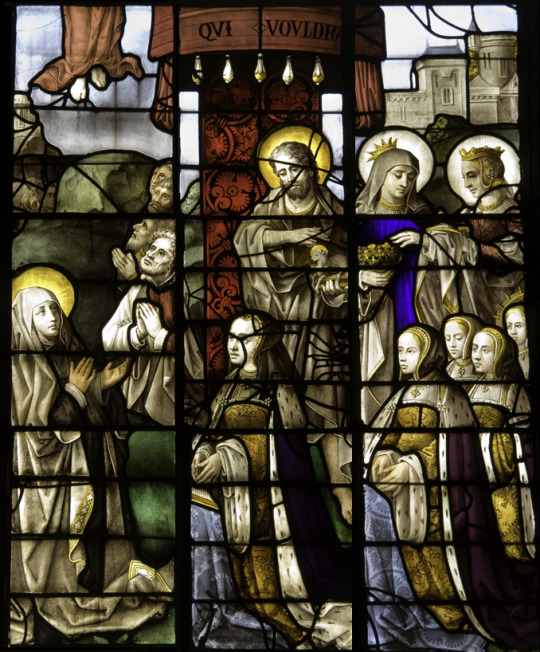
After i tried fixing the damage, removed the gaps and backrground:

(the damage was right across Joanna's face, i tried guys.) I believe the fashion points to late 1500s, or extremely early into 1510s, long before girls were of the age they are depicted at.
(This is kind of typical of this type of depictions-daughters behind their mother). Thus after Joanna left, probably after she got locked up, and the youngest-Catherine seems as an afterthought.
She was born in 1507. I would date this aproximately 1507-1510. Which is not far from c.1510 estimate.
Closest match is this portrait of Margaret, but in stained glass you see later shapes of netherlandish subtype of french hood.
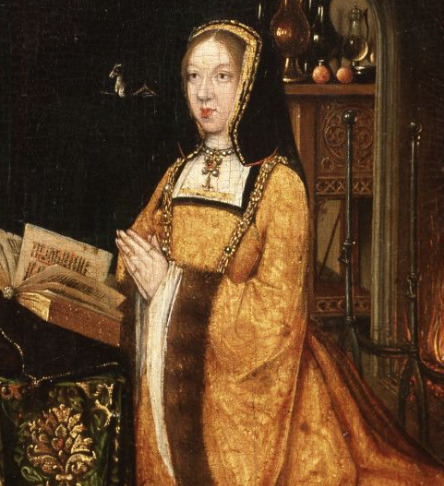
(Problem is that experts disagree upon when it was created. It used to be dated as c.1505, c.1506, but for example now museum of fine arts Gent-which owns it- has it as 15/16 century. I think the reason for 15th century notion is that it got atributed to artist called Master of 1499. But obviously the artist was active for more than one year!)
But Joanna and girls are not the only Habsburg royals depicted.
I will get to Habsburg men in Saint Waltrude when i find good closeup of them. I keep finding bad ones. But there are more royal ladies.
Photo from same place(Saint-Waltrude) can be found on pinterest:

It is thought to depict Mary of Burgundy and Margaret of Austia.
Reason for it is that the mother(on right) is beneath St. Mary Magdalene(holding a jar), while the daughter(on left) is beneath St. Margaret(atribute is ment to be the dragon by her feet-it is more of a weird lizard thing).
This is best i could come up with(it is photoshopped):
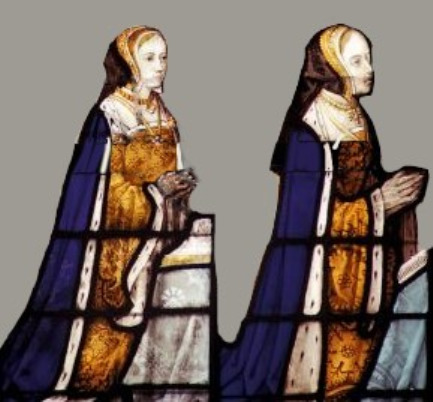
(because the gowns were not fitting together when you removed the gaps).
Obviously Mary of Burgundy is depicted posthumously in outfit not from her lifetime-but possibly using portrait for the face. Imo, this window was created tiny bit after the previous, but it might be just a year or two. It leans a tiny bit more towards 1510s. I think the artist finished one window then moved to the next one, which Habsburgs commissioned.
I hope you have enjoyed this. Tell me what you think.
#habsburgs#stained glass#early 16th century#margaret of austria#joanna of castile#mary of burgundy#isabella of austria#eleanor of austria#mary of austria#mary of hungary
13 notes
·
View notes
Text

Portrait of Queen Jadwiga Anjou
Artist: Marcello Bacciarelli (Italian, 1731–1818)
Date: 1768-1771
Medium: Oil on tin plate
Collection: Royal Castle in Warsaw, Poland
Queen Jadwiga of Poland
Jadwiga (1373 or 1374 – 17 July 1399), also known as Hedwig (from German) and in Hungarian: Hedvig, was the first woman to be crowned as monarch of the Kingdom of Poland. She reigned from 16 October 1384 until her death. Born in Buda, she was the youngest daughter of Louis I of Hungary and Poland, and his wife, Elizabeth of Bosnia.
#portrait#painting#fine art#queen jadwiga of poland#polish queen#costume#head cover#crown#pearl necklace#polish history#hedwig#polish monarch#kingdom of poland#marcello bacciarelli#italian painter#oil painting#italian art#18th century painting#artwork#european art
23 notes
·
View notes
Note
FIFTEEN? royal diaries? never knew there was so much. My best friend sure must get on with it to tell me all about all the one i don't know about lmao
There are twenty of them! Here's the full list:
Elizabeth I: Red Rose of the House of Tudor, England, 1544 by Kathryn Lasky (1999)
Cleopatra VII: Daughter of the Nile, Egypt, 57 B.C. by Kristiana Gregory (1999)
Isabel: Jewel of Castilla, Spain, 1466 by Carolyn Meyer (2000)
Marie Antoinette: Princess of Versailles, Austria-France 1769 by Kathryn Lasky (2000)
Anastasia: The Last Grand Duchess, Russia, 1914 by Carolyn Meyer (2000)
Nzingha: Warrior Queen of Matamba, Angola, Africa, 1595 by Patricia McKissack (2000)
Kaiulani: The People's Princess, Hawaii, 1889 by Ellen Emerson White (2001)
Lady of Ch'iao Kuo: Warrior of the South, Southern China, 531 A.D. by Laurence Yep (2001)
Victoria: May Blossom of Britannia, England, 1829 by Anna Kirwan (2001)
Mary, Queen of Scots: Queen Without a Country, France, 1553 by Kathryn Lasky (2002)
Sŏndŏk: Princess of the Moon and Stars, Korea, 595 A.D. by Sheri Holman (2002)
Jahanara: Princess of Princesses, India, 1627 by Kathryn Lasky (2002)
Eleanor: Crown Jewel of Aquitaine, France, 1136 by Kristiana Gregory (2002)
Elisabeth: The Princess Bride, Austria-Hungary, 1853 by Barry Denenberg (2003)
Kristina: The Girl King, Sweden, 1638 by Carolyn Meyer (2003)
Weetamoo: Heart of the Pocassets, Massachusetts-Rhode Island, 1653 by Patricia Clark Smith (2003)
Lady of Palenque: Flower of Bacal, Mesoamerica, A.D. 749 by Anna Kirwan (2004)
Kazunomiya: Prisoner of Heaven, Japan, 1858 by Kathryn Lasky (2004)
Anacaona: Golden Flower, Haiti, 1490 by Edwidge Danticat (2005)
Catherine: The Great Journey, Russia, 1743 by Kristiana Gregory (2005)
I read every single one of them.
8 notes
·
View notes
Text
Wives and Daughters of Holy Roman Emperors: Age at First Marriage
I have only included women whose birth dates and dates of marriage are known within at least 1-2 years, therefore, this is not a comprehensive list.
This list does not include women who died before their husbands were crowned Emperor. It spans between the beginning of the reign of Otto I (962 CE) and the end of the reign of Francis II (1806 CE).
The average age at first marriage among these women was 17. The sample size was 91 women. The youngest bride, Bianca Maria Sforza, was just 2 years old when she wed her first husband, who was himself 9. The oldest bride, Constance of Sicily, was 32 years old.
Adelaide of Italy, wife of Otto I, HRE: age 15 when she married Lothair II, King of Italy, in 947 CE
Liutgarde of Saxony, daughter of Otto I, HRE: age 15 when she married Conrad the Red, Duke of Lorraine, in 947 CE
Theophanu, wife of Otto II, HRE: age 17 when she married Otto in 972 CE
Cunigunde of Luxembourg, wife of Henry II, HRE: age 24 when she married Henry in 999 CE
Gisela of Swabia, wife of Conrad II, HRE: age 12 when she married Brun I of Brunswick in 1002 CE
Agnes of Poitou, wife of Henry III, HRE: age 18 when she married Henry in 1043 CE
Matilda of Germany, daughter of Henry III, HRE: age 11 when she married Rudolf of Rheinfelden in 1059 CE
Judith of Swabia, daughter of Henry III, HRE: age 9 when she married Solomon, King of Hungary in 1063 CE
Bertha of Savoy, wife of Henry IV, HRE: age 15 when she married Henry in 1066 CE
Agnes of Waiblingen, daughter of Henry IV, HRE: age 14 when she married Frederick I, Duke of Swabia in 1086 CE
Empress Matilda, wife of Henry V, HRE: age 12 when she married Henry in 1114 CE
Beatrice I, Countess of Burgundy, wife of Frederick I, HRE: age 13 when she married Frederick in 1156 CE
Beatrice, daughter of Frederick I, HRE: age 10 when she married Guillaume II, Count of Chalon in 1173 CE
Constance, Queen of Sicily, wife of Henry IV, HRE: age 32 when she married Henry IV in 1186 CE
Beatrice of Swabia, first wife of Otto IV, HRE: age 14 when she married Otto in 1212 CE
Maria of Brabant, second wife of Otto IV, HRE: age 24 when she married Otto in 1214 CE
Constance of Aragon, first wife of Frederick II, HRE: age 19 when she married Emeric of Hungary in 1198 CE
Isabella II of Jerusalem, second wife of Frederick II, HRE: age 13 when she married Frederick in 1225 CE
Isabella of England, third wife of Frederick II, HRE: age 21 when she married Frederick in 1235 CE
Margaret of Sicily, daughter of Frederick II, HRE: age 14 when she married Albert II, Margrave of Meissen in 1255 CE
Anna of Hohenstaufen, daughter of Frederick II, HRE: age 14 when she married John III Doukas Vatatzes in 1244 CE
Marie of Luxembourg, daughter of Henry VII, HRE: age 18 when she married Charles IV of France in 1322 CE
Beatrice of Luxembourg, daughter of Henry VII, HRE: age 13 when she married Charles I of Hungary in 1318 CE
Margaret II, Countess of Hainaut, wife of Louis IV, HRE: age 13 when she married Louis in 1324 CE
Matilda of Bavaria, daughter of Louis IV, HRE: age 10 when she married Frederick II, Margrave of Meissen in 1323 CE
Beatrice of Bavaria, daughter of Louis IV, HRE: age 12 when she married Eric XII of Sweden in 1356 CE
Anna von Schweidnitz, wife of Charles IV, HRE: age 14 when she married Charles in 1353 CE
Elizabeth of Pomerania, wife of Charles IV, HRE: age 16 when she married Charles in 1378 CE
Margaret of Bohemia, daughter of Charles IV, HRE: age 7 when she married Louis I of Hungary in 1342 CE
Catherine of Bohemia, daughter of Charles IV, HRE: age 14 when she married Rudolf IV, Duke of Austria in 1356 CE
Elisabeth of Bohemia, daughter of Charles IV, HRE: age 8 when she married Albert III, Duke of Austria in 1366 CE
Anne of Bohemia, daughter of Charles IV, HRE: age 16 when she married Richard II of England in 1382 CE
Margaret of Bohemia, daughter of Charles IV, HRE: age 8 when she married John III, Burgrave of Nuremburg in 1381 CE
Barbara of Cilli, wife of Sigismund, HRE: age 13 when she married Sigismund in 1405 CE
Elizabeth of Luxembourg, daughter of Sigismund, HRE: age 13 when she married Albert II of Germany in 1422 CE
Eleanor of Portugal, wife of Frederick III, HRE: age 18 when she married Frederick in 1452 CE
Kunigunde of Austria, daughter of Frederick III, HRE: age 22 when she married Albert IV, Duke of Bavaria in 1487 CE
Bianca Maria Sforza, wife of Maximilian I, HRE: age 2 when she married Philibert I, Duke of Savoy in 1474 CE
Margaret of Austria, daughter of Maximilian I, HRE: age 17 when she married John, Prince of Asturias in 1497 CE
Barbara von Rattal, daughter of Maximilian I, HRE: age 15 when she married Siegmund von Dietrichstein in 1515 CE
Dorothea of Austria, daughter of Maximilian I, HRE: age 22 when she married Johan I of East Frisia in 1538 CE
Isabella of Portugal, wife of Charles V, HRE: age 23 when she married Charles in 1526 CE
Maria of Austria, daughter of Charles V, HRE: age 20 when she married Maximilian II, HRE in 1548 CE
Joanna of Austria, daughter of Charles V, HRE: age 17 when she married John Manuel, Prince of Portugal in 1552 CE
Margaret of Parma, daughter of Charles V, HRE: age 14 when she married Alessandro de’ Medici, Duke of Florence, in 1536 CE
Elizabeth of Austria, daughter of Ferdinand I, HRE: age 16 when she married Sigismund II Augustus of Poland in 1543 CE
Anna of Austria, daughter of Ferdinand I, HRE: age 17 when she married Albert V, Duke of Bavaria in 1546 CE
Maria of Austria, daughter of Ferdinand I, HRE: age 15 when she married William of Julich-Cleves-Berg in 1546 CE
Catherine of Austria, daughter of Ferdinand I, HRE: age 16 when she married Francesco III Gonzaga in 1559 CE
Eleanor of Austria, daughter of Ferdinand I, HRE: age 27 when she married William I, Duke of Mantua in 1561 CE
Barbara of Austria, daughter of Ferdinand I, HRE: age 26 when she married Alfonso II d’Este in 1565 CE
Joanna of Austria, daughter of Ferdinand I, HRE: age 18 when she married Francesco I de’ Medici in 1565 CE
Anna of Austria, daughter of Maximilian II, HRE: age 21 when she married Philip II of Spain in 1570 CE
Elisabeth of Austria, daughter of Maximilian II, HRE: age 16 when she married Charles IX of France in 1570 CE
Anna of Tyrol, wife of Matthias, HRE: age 26 when she married Matthias in 1611 CE
Eleonora Gonzaga the Elder, wife of Ferdinand II, HRE: age 24 when she married Ferdinand in 1622 CE
Maria Anna of Austria, daughter of Ferdinand II, HRE: age 25 when she married Maximilian I, Elector of Bavaria in 1635 CE
Cecilia Renata of Austria, daughter of Ferdinand II, HRE: age 26 when she married Władysław IV of Poland in 1637 CE
Maria Anna of Spain, wife of Ferdinand III, HRE: age 25 when she married Ferdinand in 1631 CE
Maria Leopoldine of Austria, wife of Ferdinand III, HRE: age 16 when she married Ferdinand in 1648 CE
Eleonora Gonzaga the Younger, wife of Ferdinand III, HRE: age 21 when she married Ferdinand in 1651 CE
Mariana of Austria, daughter of Ferdinand III, HRE: age 15 when she married Philip IV of Spain in 1649 CE
Eleonore of Austria, daughter of Ferdinand III, HRE: age 17 when she married Michael I of Poland in 1670 CE
Maria Anna Josepha of Austria, daughter of Ferdinand III, HRE: age 24 when she married Johann Wilhelm II, Elector Palatine in 1678 CE
Margaret Theresa of Spain, wife of Leopold I, HRE: age 15 when she married Leopold in 1666 CE
Claudia Felicitas of Spain, wife of Leopold I, HRE: age 20 when she married Leopold in 1673 CE
Eleonore Magdalene of Neuberg, wife of Leopold I, HRE: age 21 when she married Leopold in 1676 CE
Maria Antonia of Austria, daughter of Leopold I, HRE: age 16 when she married Maximilian II Emanuel, Elector of Bavaria in 1685 CE
Maria Anna of Austria, daughter of Leopold I, HRE: age 25 when she married John V of Portugal in 1708 CE
Wilhelmine Amalie of Brunswick, wife of Joseph I, HRE: age 26 when she married Joseph in 1699 CE
Maria Josepha of Austria, daughter of Joseph I, HRE: age 20 when she married Augustus III of Poland in 1719 CE
Maria Amalia of Austria, daughter of Joseph I, HRE: age 21 when she married Charles VII, HRE in 1722 CE
Elisabeth Christine of Brunswick, wife of Charles VI, HRE: age 17 when she married Charles in 1708 CE
Maria Theresa of Austria, daughter of Charles VI, HRE: age 19 when she married Francis I, HRE in 1736 CE
Maria Anna of Austria, daughter of Charles VI, HRE: age 26 when she married Charles Alexander of Lorraine in 1744 CE
Maria Antonia of Bavaria, daughter of Charles VII, HRE: age 23 when she married Frederick Christian, Elector of Saxony in 1747 CE
Maria Anna Josepha of Bavaria, daughter of Charles VII, HRE: age 20 when she married Louis George of Baden-Baden in 1755 CE
Maria Josepha of Bavaria, daughter of Charles VII, HRE: age 26 when she married Joseph II, HRE in 1765 CE
Maria Christina, daughter of Francis I, HRE: age 24 when she married Albert Casimir, Duke of Teschen in 1766 CE
Maria Amalia, daughter of Francis I, HRE: age 23 when she married Ferdinand I, Duke of Parma in 1769 CE
Maria Carolina, daughter of Francis I, HRE: age 16 when she married Ferdinand IV & III of Sicily in 1768 CE
Maria Antonia, daughter of Francis I, HRE: age 14 when she married Louis XVI of France in 1770 CE
Maria Josepha of Bavaria, wife of Joseph II, HRE: age 26 when she married Joseph in 1765 CE
Maria Luisa of Spain, wife of Leopold II, HRE: age 19 when she married Leopold in 1764 CE
Maria Theresa of Austria, daughter of Leopold II, HRE: age 20 when she married Anthony of Saxony in 1787 CE
Maria Clementina of Austria, daughter of Leopold II, HRE: age 20 when she married Francis I of Sicily in 1797 CE
Maria Theresa of Naples, wife of Francis II, HRE: age 18 when she married Francis in 1790 CE
Marie Louise, daughter of Francis II, HRE: age 19 when she married Napoleon I of France in 1810 CE
Maria Leopoldina, daughter of Francis II, HRE: age 20 when she married Pedro I of Brazil and IV of Portugal in 1817 CE
Clementina, daughter of Francis II, HRE: age 18 when she married Leopold of Salerno in 1816 CE Marie Caroline, daughter of Francis II, HRE: age 18 when she married Frederick Augustus of Saxony in 1819 CE
34 notes
·
View notes
Text

Saint Elizabeth of Portugal
1271 - 1336 Feast day: July 4 (New), July 8 (Trad) Patronage: victims of adultery, jealousy, and unfaithfulness; Portugal; brides; charitable societies and workers; difficult marriages; falsely accused people; widows
St. Elizabeth of Portugal, also known as St Elizabeth of Aragon and St Isabella of Portugal was queen consort of Portugal and a tertiary of the Franciscan Order. Her great aunt was St. Elizabeth of Hungary, after whom she was named.
Prints, plaques & holy cards available for purchase here: (website)
55 notes
·
View notes
Text








Women’s History Meme || Scandals (big or small) (4/5) ↬ The abduction of Marie of Calabria
This task became increasingly difficult, particularly after the rivalry between the Tarantini and Durazzeschi was exacerbated by the clandestine (and possibly forced) 1343 marriage of Mary of Naples (then only thirteen) to Charles of Durazzo (1323–48). Mary stood second in line to the throne; the marriage, which made Charles the husband of Naples’ possible future queen, violated the terms of Mary’s betrothal to Louis of Hungary but had tacit papal approval. Naples became a hotbed of intrigue that threatened to erupt into open feuding. Clement VI was obliged to maintain constant contact with the Neapolitan branches of the Angevin family, with Johanna and her advisors, and with the increasingly irate Hungarians as he struggled to sustain the fragile peace within this most dysfunctional of families. — From She-Wolf to Martyr: The Reign and Disputed Reputation of Johanna I of Naples by Elizabeth Casteen But Agnes [of Périgord], having anticipated this response, was ready for it. Two days later, on March 28, the house of Durazzo launched the second, covert half of its plan. One of Maria’s ladies- in- waiting, a young woman by the name of Margherita di Ceccano, herself the niece of a cardinal, was an accomplice to the plot. With Margherita’s help, Charles of Durazzo quietly lured his young fiancée into the west garden of the Castel Nuovo, which abutted the grounds of his family’s estate. According to Domenico da Gravina, from there he “abducted” her to his castle, where a sympathetic priest was waiting. This priest, by the power invested in him in accordance with one of the secret bulls signed by the pope, then hurriedly and secretly married the couple. But the performance of so unorthodox a nuptial sacrament was not enough to assure Charles of his bride. So just to make certain that there was no going back, as soon as the priest was finished, the duke of Durazzo took the precaution of consummating the marriage. Or, as Domenico da Gravina, relaying information that was obviously common knowledge at the time, reported, “having intercourse, it is said, and keeping her in his own palace.” Even an environment as sexually permissive as court life in Naples apparently had its limits. Charles’ and Maria’s behavior scandalized the kingdom. Worse, it goaded the house of Taranto to drop its diplomatic effort in favor of a strategy centered on armed conflict. — The Lady Queen: The Notorious Reign of Joanna I, Queen of Naples, Jerusalem, and Sicily by Nancy Goldstone
#women's history meme#maria of calabria#capetian house of anjou#italian history#medieval#french history#european history#women's history#nanshe's graphics
16 notes
·
View notes
Text


🔸December 1st, 2021 - World AIDS Day
Mercuryphoenixtrust.com
"We are here to celebrate the life of Freddie Mercury, an extraordinary rock star who rushed across our cultural landscape like a comet shooting across the sky. We are also here to tell the whole world that he, like others we have lost to AIDS, died before his time.
The bright light of his talent exhilarates us even now that his life has been so cruelly extinguished.
I needn't have happened.
It shouldn't have happened.
Please let's not let it happen again"
- Elizabeth Taylor
'The Freddie Mercury Tribute', April 20, 1992
- Elizabeth Rosemond Taylor (February 27, 1932 - March 23, 2011), British-American actress, businesswoman, and humanitarian -
📸 'Magic Tour'
Summer 1986
July 27th, 1986 - Queen Story!
Queen perform at the Nepstadion, Budapest, Hungary
👉 December 1st, 2019 - World AIDS Day
🔸In 1988, the WHO declared 1st December as the first World AIDS Day.
The groundwork was laid for a nationwide HIV and AIDS care system in the USA that was later funded by the Ryan White CARE Act.
1991
In 1991, the Visual AIDS Artists Caucus launched the Red Ribbon Project to create a symbol of compassion for people living with HIV and their carers. The red ribbon became an international symbol of AIDS awareness.
(read on: https://www.avert.org/professionals/history-hiv-aids/overview)
#world aids day#freddie mercury#queen band#london#zanzibar#legend#queen#brian may#john deacon#freddiebulsara#roger taylor#elizabeth taylor#freddie mercury tribute#1992#magic tour
23 notes
·
View notes